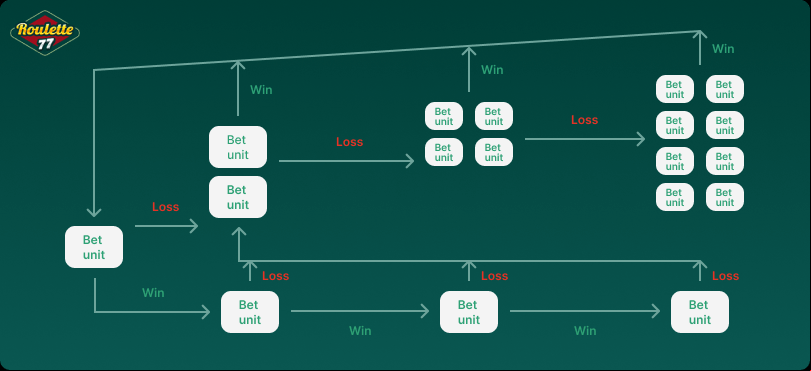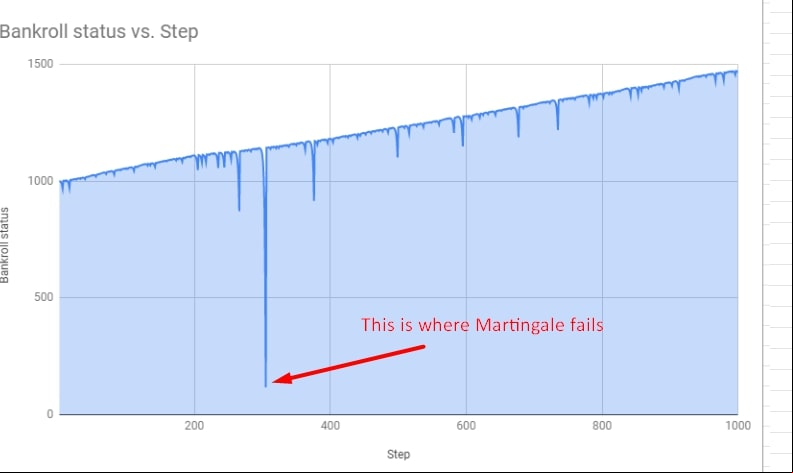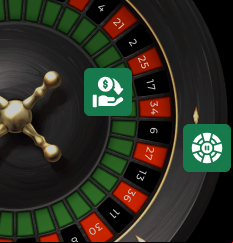How Does The Martingale Strategy Work?
In essence, Martingale system is a pretty straightforward. The whole idea behind it is for the player to start with small bets, like AU$1, and gradually increase them. But AU$1 is just a starting point. You can begin with even smaller bets if the game you're playing allows it, like AU$0.10, for instance.
The basic idea behind Martingale algorithm is to bet your baseline amount every time you win, and if you lose, keep doubling your bet until you win. This way, you can make up for your previous losses. Once you've won, you go back to your default bet, which is your starting point. Keep in mind, however, that this strategy works best for even money bets like Red/Black, Even/Odd, and Higher/Lower. While the odds of winning are not 50% even for even money bets, they’re fairly close to that margin - especially with some versions such as French Roulette. Here's a diagram that explains the strategy a bit better:

Now, let’s put the Martingale system into practice by giving you a real example of how one would bet using it. For this example, we’ll set the base bet at AU$ 1.
How to play Roulette with Martingale system?
- Step 1
Place your AU$1 bet on Black. If you win, you bet AU$ 1 on Black again. If you lose, you’ll need to double your bet for the next round. For this example, let’s say that you’ve lost your first bet.
- Step 2
Double your bet and place AU$2 on Black and wait for the outcome. For the purpose of this example, let’s say that you’ve lost your second bet too.
- Step 3
Double down your bet again and place AU$4 on Black. Let’s say you’ve lost again. Repeat again, and place AU$8 (double the previous amount) on Black, and you win AU$16 (your bet plus your winnings). With this, you have compensated for the amount you’ve lost in the previous bets and won your base bet, which was AU$1 on top of it.
- Step 4
Start with the base bet of AU$1 and repeat the sequence.
Testing the Martingale System
Our team tested the Martingale betting system to help you understand its effectiveness. We created a specific test using Google Sheets based on RNG with specific probabilities.
We chose to use Google Sheets because testing the strategy directly in a game would take more time and be harder to represent visually using a diagram. We made 1000 spins using the Martingale algorithm with a starting bet of AU$1 and a bankroll of AU$1,000. Our diagram shows how efficient the system was and how much it paid out. In the end, we were able to increase our bankroll, but there were some tense moments along the way when we could lose our entire bankroll.

The graph might suggest a steady increase in bankroll, but it's not all as promising as it looks. While the final result is positive, the bankroll dropped to AU$118 around the 300th spin. So, what exactly happened? Well, with an accumulated bankroll of AU$ 1140, a series of 10 consecutive losses occurred. With a base bet of AU$1, the total amount lost was AU$1021 (1+2+4+8+16+32+64+128+256+512).
The next step would be to bet AU$1024 to win back the money that has been lost in the previous turns, but with a bankroll of AU$118, that’s impossible. So, in the real world, the player would either have to bet AU$ 1024, try a different strategy, or stop the progression and end the game with a loss. The model depicted in the chart is purely theoretical and shows what would happen with an unlimited bankroll.
For a more realistic depiction, we conducted a similar experiment but with a bankroll of AU$300 and 100 moves. To make it more objective, we run the test with three players in parallel.

As you can see from the diagram, the only player that made it to the 100th spin was the first player winning AU$359, or AU$59 more than they started with.
The second player hit a roadblock around the 96th spin and ended up with AU$94 in their bankroll, while the third player hit the progression cap on the 25th spin and ended up with a net bankroll of AU$54. So, what can we learn from this example? It's simple - Martingale system fails if a series of losses is high enough to disrupt your progression.
The interruptions in our test happened when 10 losses in a row occurred. The probability of experiencing 10 losses in a row is P = (0.524)^10 = 0.1275% for European and 0.1631% for American roulette. Although small, experiencing 10 losses in a row is not an unlikely outcome - especially when you take into 1000 spins.
In the second test, Player 2 and Player 3 were forced out of the progression after 8 consecutive losses. The probability of experiencing 8 consecutive losses is P = (0.524)^8 = 0.5683% - for European Roulette and 0.5859% for American roulette.
Martingalge System Pros and Cons
Our tests have provided valuable insights into this strategy. Let’s explore the main weaknesses of the Martingale system and see if they can be avoided.
Betting Limits and Restrictions
When using this strategy, it's important to keep in mind that the amount you'll need to bet may exceed the table limits. The maximum limits for bets on even money odds can reach several thousand or even tens of thousands of dollars. In this case, it's unlikely you'll reach the limits. However, the limits can also be set at a thousand or several hundred dollars - it depends on the casino. So, it's important to pay attention to this.
Bigger Bankroll Equals More Success
Being a progressive strategy, you’ll need more to execute it during a losing streak. That’s why the Martingale system is most recommended for players with a bigger bankroll since they’re more likely to stick to the progression longer.
Consistency and Patience
The key to making the Martingale system work is to play consistently and be patient. You need to play at least 100 spins of the game to have a chance of success. This is why you shouldn't focus on making a profit or setting unrealistic goals, but instead stick to the algorithm and hope it doesn't fall apart and you’re not hit with a long losing session too soon.
Verdict
When searching for Roulette betting strategies on the internet, the Martingale betting system will probably be the first one you’ll come across, with many sources presenting it as a "winning" strategy. This type of rhetoric discredits the authors, who often aim to mislead readers into using the strategy for their own profit through links. Here are our genuine findings about this strategy.
In theory, the Martingale system is perfect. If there are no limits on bets and you have unlimited money, you’ll end up as a winner using the Martingale betting system in 100% of the cases. However, the reality is that neither players have unlimited money nor do tables with no limits exist.
Using the Martingale system is a time-consuming process. You need to play for a long time and with a relatively big bankroll to win a very little amount of money. The progression grows very slowly since that’s the nature of the strategy - no matter how much you bet, you only win as much as the base bet.
Another thing to point out is that eventually, you’ll have to go beyond the table limits and your bankroll, and when it occurs, you’ll likely have to use other strategies or exit the game.
So, is the Martingale betting system a scam? No, it’s not. If you have a big bankroll, a lot of time on your hands, a manage to find a table with high betting limits, then you’ll likely win a small amount of money with it.















